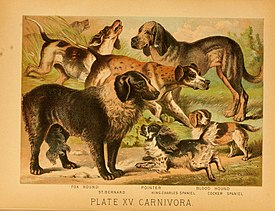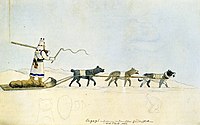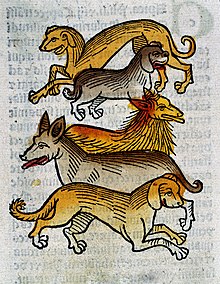Dog breed

A dog breed is a particular type of
A dog breed will consistently produce the physical traits, movement and temperament that were developed over decades of selective breeding. For each breed they recognize,
Prior to the standardization of dog breeds, there were many different types of dogs that were defined by their own, unique functions. Many different terms were used to describe dogs, such as breed, strain, type, kind, and variety. By the end of the Victorian era, society had changed and so did the role of dogs. The form was given a more prominent role than function.

First dog breeds


In 2017, a study showed that 9,000 years ago the domestic dog was present at what is now Zhokhov Island, arctic north-eastern Siberia, which was connected to the mainland at that time. The dogs were selectively bred as either sled dogs or as hunting dogs, which implies that a sled dog standard and a hunting dog standard existed at that time. The optimal maximum size for a sled dog is 20–25 kg (44–55 lb) based on thermo-regulation, and the ancient sled dogs were between 16–25 kg (35–55 lb). The same standard has been found in the remains of sled dogs from this region 2,000 years ago and in the modern Siberian Husky breed standard. Other dogs were larger at 30 kg (66 lb) and appear to be dogs that had been crossed with wolves and used for polar-bear hunting.[10]
Between 3,000 and 4,000 years ago greyhound-types of dogs were depicted on pottery and paintings in Egypt and Western Asia. Mastiff-type dogs were kept for guarding and hunting, and short-legged dogs were also bred.[11] Most modern dog breeds are the products of the controlled breeding practices of the Victorian era (1830-1900),[12][13] and the accurate documenting of pedigrees with the establishment of the English Kennel Club in 1873 in imitation of other stud book registries for cattle and horses.[14]
Genetic evidence

The domestic dog is the first species, and the only large
A genetic study identified 51 regions of the dog genome which were associated with phenotype variation among breeds in the 57 traits studied, which included body, cranial, dental, and long bone shape and size. There were three quantitative trait loci that explained most of the phenotype variation. Indicators of recent selection were shown by many of the 51 genomic regions that were associated with traits that define a breed, which include body size, coat characteristics, and ear floppiness.[18]
| ||||||||||||||||||||||||||||||
| Cladogram of nine breeds that are genetically divergent from others[19] |
Ancient dog breeds
"Ancient breed" is a term formerly, but no longer, used for a particular group of dog breeds by the American Kennel Club.[13][20] These breeds were referred to as "ancient", as opposed to modern, breeds because historically it was believed their origins dated back more than 500 years.
In 2004, a study looked at the microsatellites of 414 purebred dogs representing 85 breeds. The study found that dog breeds were so genetically distinct that 99% of individual dogs could be correctly assigned to their breed based on their genotype, indicating that breeding barriers (pure-bred breeding) have led to distinct genetic units. The study identified 9 breeds that could be represented on the branches of a phylogenetic tree which grouped together with strong statistical support and could be separated from the other breeds with a modern European origin. These 9 breeds had been referred to as "ancient breeds". The study found that the Pharaoh Hound and Ibizan Hound were not as old as once believed; rather, they had been recreated from combinations of other breeds, and that the Norwegian Elkhound grouped with the other European dogs despite reports of direct Scandinavian origins dating back 5,000 years.[19]
Dog types

The spread of modern dog breeds has been difficult to resolve because many are the product of the controlled breeding practices of the Victorian era (1830–1900).[12][13] In 2010, a study looked at 48,000 single nucleotide polymorphisms that gave a genome-wide coverage of 912 dogs representing 85 breeds.[21]
The study found distinct genetic clusters within modern dogs that largely corresponded to
The study found that there were three well-supported groups that were highly divergent and distinct from modern domestic dogs.
- an Asian group (Akita and Shar Pei)
- a Middle Eastern group (Afghan hound and Saluki)
- a northern group (Alaskan Malamute and Siberian Husky).[21]
The earliest books in the English language to mention numbers of dog types are from the "Cynegetica" (hunting literature), namely, The Art of Venery (1327) by Twiti (Twici), a treatise that describes hunting with the
Basal breeds
A study in 2012 examined 49,000

The 2012 study found that modern breeds only emerged in the 19th century and that claims of their antiquity are based on little or no historical or empirical evidence. The study indicated that throughout history, global dog populations experienced numerous episodes of diversification and homogenization, with each round further reducing the power of genetic data derived from modern breeds to help infer their early history.[28]
Of the basal breeds, the American Eskimo Dog and Eurasier were the very recent product of cross-breeding other basal breeds. Most basal breeds have hybridized with other lineages in the past. If those other lineages were other basal breeds then a basal genetic signature remains. The combination of introgression and past population bottlenecks suggested that basal breeds have little or no genetic connections to their ancestral populations and that their genetic distinctiveness does not signify ancient heritage. They are distinctive from the modern breeds because the genetic heritage of the modern breeds has become blurred due to admixture, and the basal breeds have mostly avoided admixture with them due to geographic or cultural barriers.[28]
Medical research
As dogs are a subspecies but their breeds are distinct genetic units, and because only certain breeds share the same type of cancers as humans, the differences in the genes of different breeds may be useful in human medical research.[29]
Breed temperament
In 2014, a study indicated that some breed-temperaments, such as anxiety or fear, may be linked to gene mutations. Other temperaments may be due to the legacies of 'ancient' ancestry.[30]
Breeds
Pure breeds
Kennel clubs
Groups of owners that have dogs of the same breed and have an interest in
A dog breed is represented by a sufficient number of individuals to stably transfer its specific characteristics over generations. Dogs of same
Kennel clubs provide the recognition of distinct dog breeds, but there are many independent clubs with differing, and sometimes inconsistent standards and they need not apply scientific standards. Four varieties of the
A dog is said to be
In Canada, the Animal Pedigree Act lays out strict standards for the documenting of what it calls "evolving breeds".[35][36]
Breed standards
The
Major registries
Dogs with a breed standard may be accepted into one or more of the major registries (
Fédération Cynologique Internationale (FCI) is neither a breed registry nor does it issue pedigrees or keep addresses for breeders.[39] It is a global canine organization with member and contract partners (one member per country) that conduct international conformation shows, working/hunting/herding trials, and various other events. The results are submitted to FCI for processing, approval and international recognition. Each of the member and contract partners issue and maintain their own pedigrees and respective breed standards, and train their own judges. FCI ensures that each member mutually recognizes the pedigrees and judges of all FCI members.[40]
Health issues
Purebred dogs have more health problems than mongrel dogs, and require more veterinary visits,[41] and tend to have lower longevity.[42][43] Indeed, studies have reported lifespans that are shorter by between one and almost two years.[44][45] Notably, dog breeds with flat faces and short noses have breathing difficulties,[46] eye trouble and other health issues.[47]
List of pure breeds
- Refer: List of dog breeds
The Fédération Cynologique Internationale is a global organisation with 98 members and contract partners (one member per country) that recognize 354 purebreds.[40]
Cross-breeds
A
Historically, crosses between dogs of different types were more well accepted at a time when modern purebred breeds (based on the eugenics principles) did not yet exist.[55][56] Some crossbred dogs, created by breeding two purebred dogs of different breeds, may have the advantage of heterosis, or crossbreed vigor. This advantage can be progressively diluted when two crossbreeds are bred in the attempt to create a breed, narrowing the gene pool. The best way to continue taking advantage of crossbreed vigor is from the breeding of dogs of purebred ancestry, as this vigor is typically seen only in the first generation cross of two purebred animals of separate breeds, thus taking advantage of genetic diversity.
Mixed-breeds
A mongrel, mixed-breed dog or mutt is a dog that does not belong to one officially recognized breed but can be a mix of two breeds and is not the result of intentional breeding.[59]
In the United States, the term mixed-breed is a favored synonym over mongrel among individuals who wish to avoid negative connotations associated with the latter term.[60] The implication that such dogs must be a mix of defined breeds may stem from an inverted understanding of the origins of dog breeds. Purebred dogs have been, for the most part, artificially created from random-bred populations by human selective breeding with the purpose of enhancing desired physical, behavioral, or temperamental characteristics. Dogs that are not purebred are not necessarily a mix of such defined breeds.[61] Therefore, among some experts and fans of such dogs, mongrel is still the preferred term.[62][63][64][65]
Natural breeds
- See further: Landraces
Natural breeds rose through time in response to a particular environment and in isolation from other populations of the species.[66] This environment included humans but with little or no selective breeding by humans.[67]
Lists
See also
References
- PMID 28445722.
- ^ PMID 31598383.
- ^ "Dog Breeds - Types Of Dogs". American Kennel Club. 12 November 2017. Retrieved 8 August 2019.
- PMID 12692167.
- ^ "About Breed Standards". Home. Retrieved 9 August 2019.
- ^ "Dog Breed Profiles". Dog Breed Profiles. Retrieved 29 February 2020.
- ^ a b Worboys, Michael (13 April 2019). "The history of dog breeds". The Week. Retrieved 8 August 2019.
- ^ "History of the Kennel Club". Home. Retrieved 9 August 2019.
- ^ "Over 40% of the world's dog breeds come from these 3 countries". bigthink. 26 September 2023. Retrieved 26 September 2023.
- .
- ^ Clutton-Brock, J., 1995. Origins of the dog: domestication and early history. In:Serpell, J. (Ed.), The Domestic Dog, its Evolution, Behaviour and Interactions with People. Cambridge University Press, Cambridge, pp. 16-20
- ^ ISBN 978-0793812844.
- ^ ISBN 978-0345476265.
- ISBN 978-0-87605-624-0.
In the strictest sense, dog breeds date back only to the last couple of decades of the nineteenth century, or to more recent decades in this (the twentieth) century but distinct types of dogs have existed centuries earlier.
- ^ S2CID 26721918.
- S2CID 246387681.
- S2CID 214809393.
- .
- ^ S2CID 43772173.
- ^ American Kennel Club. "Dog breed groups".
- ^ PMID 20237475.
- ^ Twiti, William (1977). Danielsson, B.; Cynegetica Anglica (eds.). The Art of Hunting 1. Stockholm Studies in English XXXVII. Translated by Danielsson, B.; Cynegetica Anglica. Stockholm: Almqvist & Wiksell Int.
- ^ The Master of Game, by Edward, second Duke of York: ed. Baillie-Grohman, William.1st Ed. London: 1904 Ballantine, Hanson & Co Folio, 302pp. 52 pl
- ^ Edward, of Norwich; Baillie-Grohman, William A. (William Adolph); Baillie-Grohman, F. (Florence); Roosevelt, Theodore; Gaston III Phebus, Count of Foix (1 January 1909). The master of game : the oldest English book on hunting. London : Chatto & Windus.
- ^ "BNF – Le livre de chasse de Gaston Phebus". classes.bnf.fr. Retrieved 17 November 2016.
- ISBN 0-19-811715-9.
- ^ Berners, Juliana; Blades, William (1 January 1901). The boke of Saint Albans. London : Elliot Stock.
- ^ PMID 22615366.
- S2CID 28325634.
- S2CID 81062726.
- ISBN 978-0-7645-7302-6.
- ^ Lynn Marmer (1984). "The New Breed Of Municipal Dog Control Laws:Are They Constitutional?". first published in the University of Cincinnati Law Review. Archived from the original on 26 September 2000. Retrieved 13 December 2013.
The court found it was impossible to identify the breed of an unregistered dog.
- ^ "Standards of the Breeds: Group 5 – Working" (PDF). New Zealand Kennel Club.
- ^ "Get Started – Register Your Mixed Breed Dog With AKC Canine Partners". American Kennel Club. 28 July 2019. Retrieved 9 August 2019.
- ^ "Animal Pedigree Act 1985". Department of Justice, Canada. Archived from the original on 26 July 2012. Retrieved 9 April 2008.
- ^ "Secretary's manual (page 1 of 9)". 24 February 2003.
{{cite journal}}: Cite journal requires|journal=(help) - ^ American Kennel Club Glossary
- ^ "List of Breeds by Group – American Kennel Club". American Kennel Club. 2 January 2019. Retrieved 9 August 2019.
- ^ "Main activities of the FCI Secretariat". Fédération Cynologique Internationale. Retrieved 15 March 2022.
- ^ a b "Presentation of our organisation". Fédération Cynologique Internationale. Retrieved 17 March 2022.
- S2CID 24303176.
- S2CID 9721674.
- PMID 12628771.
- PMID 24206631.
- PMID 9158552.
- ^ How fashion has left this dog gasping for air
- ^ Vets warn people against buying 'flat-faced' dogs
- ^ "cross-breed". Oxford Dictionaries. Oxford University Press. 2014. Archived from the original on 17 July 2012.
- ^ Buzhardt, Lynn (2016). "VCA Hospitals". VCA.
- ^ "Show Quality Dogs". show quality dogs. 2020.
- ^ Bennett, Laura (10 December 2007). "Pet Industry Trends for 2008". smallbiztrends.com. Archived from the original on 4 July 2008.
2008 will see the rapid growth of the puppy farm crossbreeds to take advantage of the inflated prices people are paying for these dogs.
- ^ Patterson, Melissa (23 July 2008). "Not all cute and cuddly in land of 'designer dogs,'". Chicago Tribune. Archived from the original on 6 October 2008.
[crossbreed designer dog puppies] often go for more money than purebreds, which can range from $200 to $2,000 per dog.
- ^ Caesar, Ed (8 March 2007). "Hounded out: Fur and loathing in the dog world". The Independent.
the stampede to acquire one (designer dog) has become so furious that puppies now sell for as much as £2,000.
- ^ "Designer Dogs are the Rage". designerdoggies.com. Archived from the original on 4 July 2008.
the Beagle is one of the lowest priced purebred dogs, yet the Puggle often sells for much more than the purebred Pug.
- ISBN 9780807033432.
- ^ Walsh, John Henry (1859). The dog, in health and disease, by Stonehenge.
- ISBN 978-0-86547-686-8.
- PMID 16938847.
- ISBN 978-1-57076-410-3.
The mongrel is not a true breed, but it is certainly a common category of domestic dog. It has been estimated that, worldwide, there are 150 million of them."
- ISBN 978-0-944435-54-0.
Canines of unknown lineage used to be termed mongrels—how demeaning! Over time, the term 'mixed breed' was preferred.
- ISBN 978-0-670-89272-3.
- ^ Riddle, Maxwell (1954). Lovable Mongrel. All-Pets.
- ^ Cooper, Jilly (1981). Intelligent and Loyal, a Celebration of the Mongrel. London.
{{cite book}}: CS1 maint: location missing publisher (link) - ^ Patmore, Angela (1985). The Mongrel. London.
{{cite book}}: CS1 maint: location missing publisher (link) - ^ White, Kay (1997). Book of the Mongrel. HarperCollins.
- ISBN 978-0-85199-429-1. Retrieved 28 September 2014.
- ISBN 0-684-85530-5, Chapter 3, "Natural Breeds", p. 85. "Natural breeds can arise locally with no human interaction"
Further reading
- Alderton, David (September 2008). Encyclopedia of Dogs (Hardcover). Bath: Parragon Inc. p. 384. ISBN 978-1407524382.
- Coile, D. Caroline (1 April 2005). Encyclopedia of Dog Breeds: Profiles of More than 150 Breeds (2nd ed.). Barron's Educational Series, Incorporated. p. 368. ISBN 9780764157004.
- De Prisco, Andrew; Johnson, James B. (1993). Canine Lexicon. T. F. H. Publications. p. 886. ISBN 978-3-929545-60-9.
- Kister, Kenneth F. (1994). Kister's Best Encyclopedias (2nd ed.). Phoenix: Oryx. pp. 329–330. ISBN 978-0-89774-744-8.
- De Vito, Dominique (1 September 2005). World Atlas of Dog Breeds (Print) (6th ed.). Neptune City, NJ Lanham, MD: TFH Publications, Inc. Distributed in the U.S. to the Bookstore and library trade by National Book Network. p. 960. ISBN 978-0793806560.
- DK Publishing (15 July 2013). The Dog Encyclopedia (Hardcover) (1st ed.). DK Adult. p. 360. ISBN 978-1465408440.
- Wilcox, Bonnie; Walkowicz, Chris (March 1995). Atlas of Dog Breeds of the World (Print) (5th ed.). Neptune City, NJ Lanham, MD: TFH Publications, Inc. Distributed in the U.S. to the Bookstore and library trade by National Book Network. p. 912. ISBN 978-0793812844.
External links
- Fédération Cynologique Internationale breeds nomenclature, lists 339 dog breeds in 78 groups.
